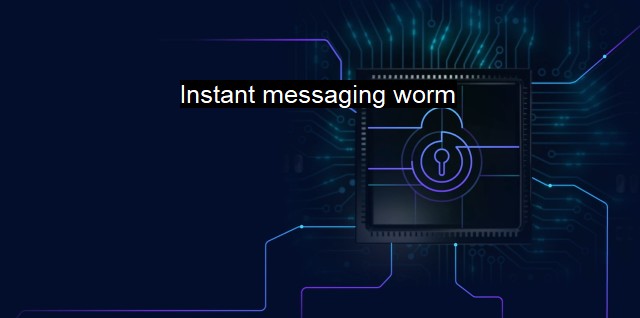What is Instant messaging worm?
The Danger Within: Understanding and Combatting Instant Messaging Worms in Today's Networks
Instant messaging worm is a type of self-replicating malware that spreads primarily through instant messaging (IM) applications. These sophisticated cybersecurity threats exploit the speed and efficiency of instant messaging channels to proliferate, primarily leveraging the extensive contact lists that each IM user typically has. A broad understanding of Instant Messaging worms is needed to appreciate the potential harm they can cause and the importance of implementing effective antivirus solutions.In cyber parlance, an instant messaging worm is essentially a type of computer worm, specifically designed to spread via IM networks. They differ from traditional computer worms due to their medium of transmission. The main attraction of instant messaging for these malicious entities is the connectivity potential and immediate reach that this platform offers due to its extensive user base and widespread popularity.
The operation mode of instant messaging worms is simple yet effective. They infiltrate an instant messaging system and use it to send copies of themselves to other individuals connected to the system. Vulnerable worm targets are not limited to IM users in the victim's contact lists, as closed-loop interactions enabled by IM networks enhance infection rates, often making cascading worm outbreaks hard to contain.
Once a user's device has been infected by such a worm, it manifests itself with a variety of tactics. It might send out messages containing a link to download the worm, disguising that link as a video or image, or a harmless executable file. When the recipient of this message clicks on the link, the download action unwittingly executed triggers the worm and quickly spreads it on the user's system.
Instant messaging worms present several inherent risks and issues. Firstly, they can overload servers and networks. That's because the worm has a tendency to replicate and resend itself out through the IM networks, causing a rapid increase in network traffic. It might effectively degrade or in severe cases, cripple network performance thus disrupting normal activities and even possibly causing financial losses.
Secondly, these worms can facilitate data theft – since worms can also act like Trojans, opening a back door to the user's system for the attacker. Once the system becomes vulnerable, personal or sensitive data can be extracted, including passwords, credit card information, among other details, leading to identity theft, fraud, or financial crimes that can have severe consequences for the victim.
Instant messaging worms can cause significant damage to the infected computers and even compromise the device's operating system by installing additional malware, deleting crucial files or altering system settings, all of which can entail potential system failures, data loss, and productivity disruptions.
In order to protect IM systems from these harmful worms, anti-virus/malware software, coupled with plenty of caution, is absolutely necessary. Updating antivirus software regularly ensures the protection module is equipped to detect and eliminate even the latest threats. Disabling file sharing and limiting file transfer options within instant messaging programs can also curb the extent of attack.
IM users are advised then, to be extraordinarily wary of opening unrecognized links or downloading files sent through instant messaging. For many worms, the first (and often easiest) line of defense is simply preventing its download and installation.
Instant Messaging worms epitomize an unchecked digital challenge exacerbated by the ubiquity and universality of the medium they exploit to inflict cyber havoc. Prioritizing cyber hygiene habits, leveraging robust antivirus tools, and maintaining situational awareness regarding what constitutes a likely worm hazard within IM spaces, can minimize this threat's impact. In this digital age, dependence on technology also calls for responsible behavior toward using it, underlining the importance of rectitude in security practices.

Instant messaging worm FAQs
What is an instant messaging worm?
An instant messaging worm is a type of malicious software that spreads through instant messaging platforms, such as Skype, WhatsApp, or Facebook Messenger. It can infect your device and replicate itself by sending messages to your friends or contacts.How can I protect myself from instant messaging worms?
To protect yourself from instant messaging worms, you should always keep your antivirus software up to date, avoid clicking on suspicious links or downloading attachments from unknown sources, and be cautious when opening messages from strangers or unexpected contacts.What are the risks of an instant messaging worm infection?
An instant messaging worm infection can lead to a range of risks, including unauthorized access to your personal data, theft of your identity, financial fraud, and even the complete takeover of your device. It's essential to take immediate actions to remove the worm once detected to prevent any further damage.What should I do if I suspect that my device has been infected by an instant messaging worm?
If you suspect that your device has been infected by an instant messaging worm, you should immediately disconnect it from the internet and run a full virus scan using your antivirus software. You should also change all your passwords and inform your contacts to prevent further spread of the worm. If you cannot remove the worm or unsure of what steps to take, consider seeking assistance from a cybersecurity professional or IT support service.| | A | | | B | | | C | | | D | | | E | | | F | | | G | | | H | | | I | | | J | | | K | | | L | | | M | |
| | N | | | O | | | P | | | Q | | | R | | | S | | | T | | | U | | | V | | | W | | | X | | | Y | | | Z | |
| | 1 | | | 2 | | | 3 | | | 4 | | | 7 | | | 8 | | |||||||